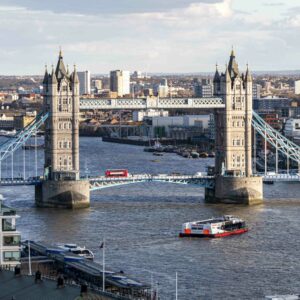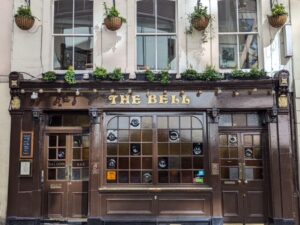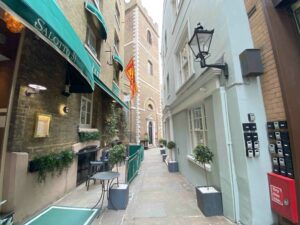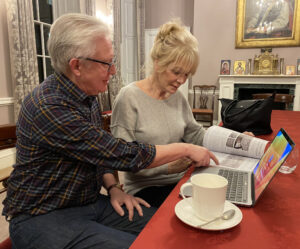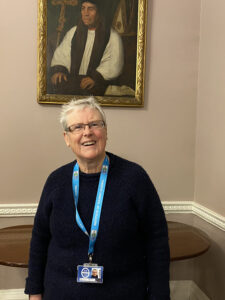The City of London is a natural habitat for cats, either of the financial fat cat variety or for ones sculpted in stone, with lions in particular adding a sprinkle of nobility to coats of arms and memorials. But instant majesty is not the only reason we see cats in public places, so as International Cat Day (8th August) approaches, let’s take a closer look at the most curious cats in the City of London.
Lion on Nelson’s monument, Great Hall, Guildhall
Starting with the king of felines is the lion which lies on the base of the Grade I listed monument to Horatio Nelson in Great Hall, Guildhall. The monument was erected to commemorate Nelson following his victory in the Battle of Trafalgar and was sculpted by James Smith in 1810.
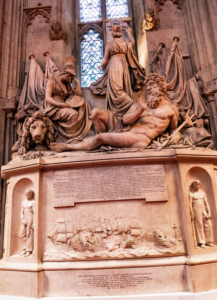
Unusually the monument does not have a figure of Nelson and instead, a female figure representing the City of London is inscribing a list of his victories onto a stele, with Trafalgar being the final entry. To the left is a figure of Britannia mournfully contemplating a medallion on which we have Nelson’s image, and Britannia is sitting on a similarly depressed looking lion with a delicately curled mane.
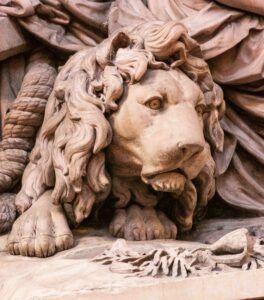
Lions have been used on monuments for centuries to evoke a sense of majesty and awe, and many royal families throughout Europe have used the lion on their coat of arms. The identification of lions with England and Britannia similarly has its origins in the royal family and lions first became associated with England at the time of Richard I, Coeur de Lion, and his mother, Eleanor of Aquitaine, who had a lion on her coat of arms.
Part of the Plantagenet dynasty, Richard’s first Great Seal had a single lion which then became three golden lions on a red field (lions passant guardant – meaning the lions are walking towards the left and looking towards the viewer) which have appeared on the royal coat of arms ever since. Technically if the lions are walking away, they are referred to as leopards, and are only referred to as lions if they are rampant, but tradition now has it that the animals on the royal coat of arms are lions. These are the Three Lions on the Shirt of the Football’s Coming Home song that the English fans had been singing in vain until recently. Congratulations to the Lionesses for making the song come true.
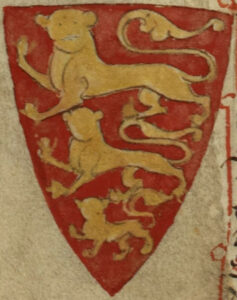
Royal lions then morphed into a single lion as the national animal of Britain and lions regularly appear on monuments for national heroes or to accompany Britannia, the personification of Britain.
Hodge – Dr Johnson’s House
Going from the poshest cat to the most ordinary, we now move to Dr Samuel Johnson’s House on Gough Square where you will find a bronze statue of Hodge, Johnson’s favourite cat.
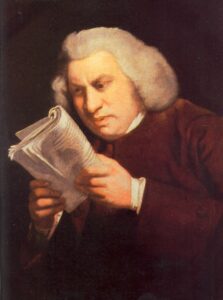
Samuel Johnson is famous for his Dictionary of the English language, published in 1755 and which for 150 years was the most widely used dictionary. Johnson was also the subject of a biography by his friend James Boswell in which Boswell describes how fond Johnson was of animals, particularly Hodge. Hodge was fed oysters, which were plentiful in the 18th century and the food of the poor, and Johnson himself would go out to buy these oysters as he didn’t want his servants growing resentful towards Hodge should they be asked to run errands on behalf of a cat.
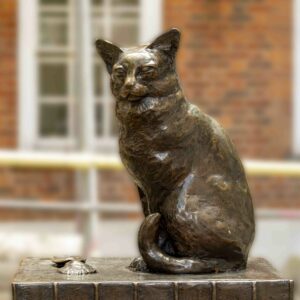
The statue was unveiled in 1997 and shows Hodge sitting next to some empty oyster shells on top of Johnson’s dictionary – the 18th century equivalent of a cat sitting on your laptop – and I can imagine Hodge interrupting Johnson’s work on this dictionary by sitting on his parchment and loudly meowing for his seafood lunch.
Goldsmith’s Leopard
Opposite Goldsmith’s Hall, the livery hall of the Worshipful Company of Goldsmiths, is Goldsmith’s Gardens and it is here that we find our next cat – a leopard. This is the Goldsmith’s leopard and is the hallmark for gold and silverware made in London and can be found to this day on London gold and silver jewellery and artefacts.
Gold
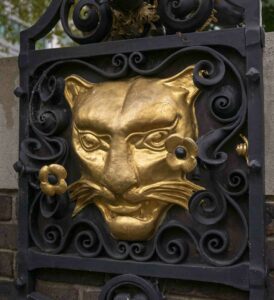
A livery company is like a guild and most livery companies today concentrate on their charitable aims. Goldsmith’s livery company is unusual in having retained its original medieval purpose of providing apprenticeships to train gold and silversmiths which it still does today. It is also the home of the London Assay Office which tests and hallmarks all gold and silver objects made in London.
The leopard’s head as a mark for silver first appeared in the 13th century in the reign of Edward I who ordered that all silver made in England had to be marked with a leopard’s head as an assurance of its quality and he tasked members of the Goldsmith’s company to go to work shops to assay (test) the silver.
The mark at this time was taken from the three lions passant on the royal coat of arms and was a lion’s head – a “leo part”. As the number of workshops in London increased, the silversmiths were asked to come to the Goldsmith’s hall to have their silver assayed and the term “hallmark” emerged. Later the lion’s head lost its mane and became more streamlined and recognisable as the leopard we see today.
Dick Whittington’s Cat – St Michael Paternoster Royal
Our next City cat belongs to Dick Whittington, the thrice Lord Mayor. This is the panto version of Dick Whittington, whereas the real Richard Whittington was four times Lord Mayor of London, a great philanthropist, and there is no evidence he was an ailurophile.
However, a good story, even if untrue, is hard to kill, and so St Michael Paternoster Royal – which was the parish church of the real Richard Whittington – has a stained-glass window designed by John Hayward depicting Dick Whittington complete with a cat. The church was severely damaged during WWII bombing and was the last City Church to be restored in the 1960s which is when the beautiful stained-glass windows were added.
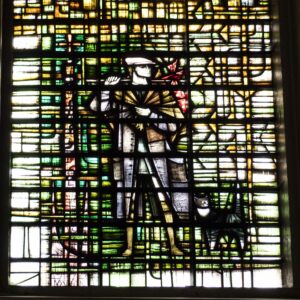
John Hayward recalls that he had to alter the design which originally showed a ginger cat standing on Dick Whittington’s shoulders – clearly John Hayward knew cats well. However, the architect restoring the church, Elidir Davis, was allergic to cats and objected to the cat rubbing itself against Dick Whittington’s head. Two panels were removed from the window and the ginger cat became a black cat at the feet of Dick Whittington, while Dick’s face was replaced and the ginger cat on his shoulders became a peaked cap.
Unfortunately, it is impossible to please everyone and descendants of Richard Whittington at the dedication ceremony complained that the peaked cap made Dick Whittington look like a poacher.
Dyers’ Incensed Panthers
Next on our City tour is another livery company with a most curious pair of cats on its coat of arms. The Worshipful Company of Dyers has panthers supporting its coats of arms and these can be seen at the entrance to the Dyers’ livery hall on Dowgate Hill.
Dyers were involved with dying cloth and their hall is located on Dowgate Hill as they needed plenty of water for the process of dying and Dowgate Hill was near to the River Thames.
The panthers are incensed, meaning there are red flames emanating from their mouth and ears, and according to Pliny and medieval historians this represents the sweet breach of the panthers which lulls all other animals into submission, except for dragons.
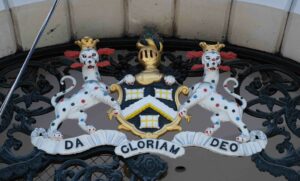
Henry VI granted the Dyers their first charter in 1471 and the panthers were added to the coat of arms a century later, either to evoke the connection to Henry who had panthers as one of his badges, or because of the coloured spots on the panthers which reminds us of the dyes used in the trade.
The main dyes used by dyers were madder (Rubia tinctorum) for red, woad (Isatis tinctoria) for blue, weld (Reseda luteola) for yellow, a combination of weld and woad for the Lincoln Green worn by Robin Hood, and a combination of madder, weld and woad which produces black. All of these colours can be found on the various iterations of the spotted panthers.
The Curious Cat of St Bartholomew the Great
Our final cat is the St Bartholomew the Great cat and like some cats is very hard to find. It is practically impossible to make out from ground level and a bit like the Nazca lines is best seen on a photograph. At the top of one of the columns in the South transept next to the Crossing is the head of a cat, disappearing Cheshire Cat-like into the stone wall.
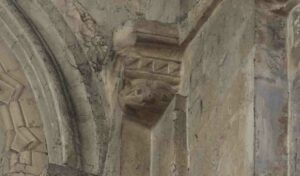
Nothing is known about the cat, and he is left to us by a medieval carver, working high up, who maybe carved his pet into the fabric of the church. Curiouser and Curiouser.
Those are the cats of the City, but let’s end this City tour with two Six in the City cats. So here is Puss owned by Jane and Bluey owned by Patrick. We have it on good authority they approve of the tour.
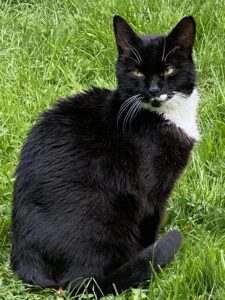
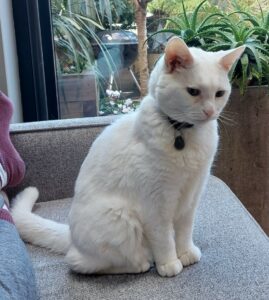
Join Ildiko on the Immigrant London walk.

